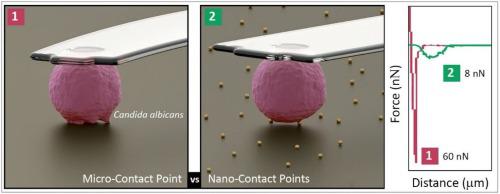Colloids and Surfaces B: Biointerfaces ( IF 5.4 ) Pub Date : 2020-06-04 , DOI: 10.1016/j.colsurfb.2020.111177 Thomas J Dauben 1 , Carolin Dewald 2 , Izabela Firkowska-Boden 1 , Christian Helbing 1 , Henrik Peisker 3 , Martin Roth 4 , Jörg Bossert 1 , Klaus D Jandt 5

|
It has been recently recognized that controlled surface structuring on the nanometer scale is a successful strategy to endow different materials with antimicrobial properties. Despite many studies on bacterial interactions with nanostructured surfaces, a quantitative link between surface topography and bacterial adhesion is still missing. To quantitatively link cell adhesion data with topographical surface parameters, we performed single-cell spectroscopy on chemically identical surfaces with controlled nano-contact point density achieved by immobilization of gold nanoparticles (AuNP) on gold thin films. Such materials surfaces have previously shown antimicrobial (anti-adhesive) efficacy towards Gram-negative Escherichia coli cells. In the current study, the influence of nano-structured surfaces on the surface coverage and adhesion forces of clinically relevant Candida albicans (C. albicans), the fungus primarily associated with implant infections, was investigated to validate their antimicrobial potency against different microbial cells. The adhesion forces of C. albicans cells to nanostructured surfaces showed a decreasing trend with decreasing contact-point density and correlated well with the results of the respective C. albicans cell counts. The surfaces with the lowest contact-point density, 25 AuNP/μm², resulted in an average adhesion force of 5 nN, which was up to 5 times lower compared to control and 61 AuNP/μm² surfaces. Further, detailed analyses of force-distance curves revealed that the work of adhesion, and thus the energy required to remove the C. albicans cell from the surface is up to 10 times lower on 25 AuNP/μm² surfaces compared to unstructured surfaces. These findings show that a controlled tuning of nanostructured surfaces in terms of accessible nano-contact points is crucial to generate surface structures with enhanced antimicrobial properties. The gained knowledge can be further exploited for the design of biomaterials surfaces to prevent adhesion of some most commonly encountered pathogens.
中文翻译:

量化表面的纳米接触点密度和白色念珠菌的附着力之间的关系。
最近已经认识到,在纳米尺度上受控的表面结构是赋予不同材料具有抗菌特性的成功策略。尽管对细菌与纳米结构表面的相互作用进行了许多研究,但表面形貌与细菌粘附之间的定量联系仍然缺失。为了定量地将细胞粘附数据与地形表面参数联系起来,我们在化学相同的表面上进行了单细胞光谱分析,并通过将金纳米颗粒(AuNP)固定在金薄膜上实现了可控的纳米接触点密度。此类材料表面先前已显示出对革兰氏阴性大肠杆菌的抗菌(抗黏附)功效细胞。在当前的研究中,研究了纳米结构表面对临床相关的白色念珠菌(C. albicans)(主要与植入物感染相关的真菌)的表面覆盖率和粘附力的影响,以验证其对不同微生物细胞的抗菌效力。白色念珠菌细胞对纳米结构表面的粘附力随着接触点密度的降低而呈下降趋势,并且与各个白色念珠菌的结果具有良好的相关性细胞计数。接触点密度最低的表面为25 AuNP /μm²,其平均粘附力为5 nN,与对照和61 AuNP /μm²的表面相比,其平均粘附力低5倍。此外,对力-距离曲线的详细分析显示,与非结构化表面相比,在25 AuNP /μm²表面上的粘附功以及从表面去除白色念珠菌细胞所需的能量最多低10倍。这些发现表明,就可接近的纳米接触点而言,对纳米结构表面的受控调节对于产生具有增强的抗菌性能的表面结构至关重要。所获得的知识可进一步用于生物材料表面的设计,以防止某些最常见的病原体粘附。











































 京公网安备 11010802027423号
京公网安备 11010802027423号